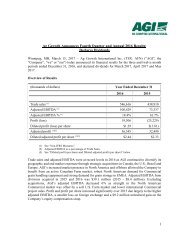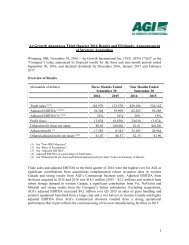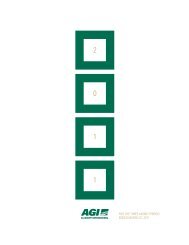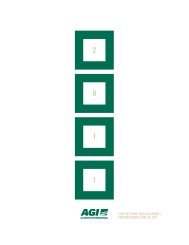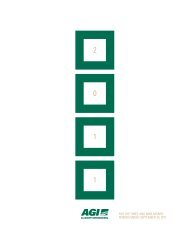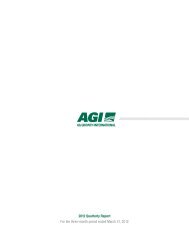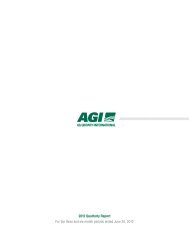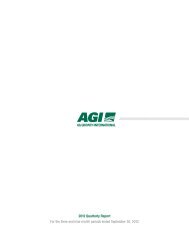2016 Annual Report For Web 7.3MB
You also want an ePaper? Increase the reach of your titles
YUMPU automatically turns print PDFs into web optimized ePapers that Google loves.
AGI uses primarily forward currency contracts as hedges of its exposure<br />
to foreign currency risk in forecast transactions and firm commitments.<br />
OFFSETTING OF FINANCIAL INSTRUMENTS<br />
Financial assets and financial liabilities are offset and the net amount<br />
reported in the consolidated statements of financial position if, and only<br />
if, there is a currently enforceable legal right to offset the recognized<br />
amounts and there is an intention to settle on a net basis, or to realize<br />
the assets and settle the liabilities simultaneously.<br />
FAIR VALUE OF FINANCIAL INSTRUMENTS<br />
Fair value is the estimated amount that AGI would pay or receive to<br />
dispose of these contracts in an arm’s length transaction between<br />
knowledgeable, willing parties who are under no compulsion to act. The<br />
fair value of financial instruments that are traded in active markets at<br />
each reporting date is determined by reference to quoted market prices,<br />
without any deduction for transaction costs.<br />
<strong>For</strong> financial instruments not traded in an active market, the fair<br />
value is determined using appropriate valuation techniques that are<br />
recognized by market participants. Such techniques may include using<br />
recent arm’s length market transactions, reference to the current fair<br />
value of another instrument that is substantially the same, discounted<br />
cash flow analysis or other valuation models.<br />
PROVISIONS<br />
Provisions are recognized when AGI has a present obligation, legal<br />
or constructive, as a result of a past event, it is probable that an<br />
outflow of resources embodying economic benefits will be required<br />
to settle the obligation and a reliable estimate can be made of the<br />
amount of the obligation. Where AGI expects some or all of a provision<br />
to be reimbursed, for example under an insurance contract, the<br />
reimbursement is recognized as a separate asset but only when<br />
the reimbursement is virtually certain. The expense relating to any<br />
provision is presented in the consolidated statements of income, net of<br />
any reimbursement. If the effect of the time value of money is material,<br />
provisions are discounted using a current pre-tax rate that reflects,<br />
where appropriate, the risks specific to the liability. Where discounting<br />
is used, the increase in the provision due to the passage of time is<br />
recognized as a finance cost.<br />
Warranty provisions<br />
Provisions for warranty-related costs are recognized when the product<br />
is sold or service provided. Initial recognition is based on historical<br />
experience.<br />
PROFIT (LOSS) PER SHARE<br />
The computation of profit (loss) per share is based on the weighted<br />
average number of shares outstanding during the period. Diluted<br />
profit (loss) per share is computed in a similar way to basic profit<br />
(loss) per share except that the weighted average shares outstanding<br />
are increased to include additional shares assuming the exercise of<br />
share options, share appreciation rights and convertible debt options, if<br />
dilutive.<br />
REVENUE RECOGNITION<br />
Revenue is recognized to the extent that it is probable that the economic<br />
benefits will flow to AGI and the revenue can be reliably measured,<br />
regardless of when the payment is being made. Revenue is measured<br />
at the fair value of the consideration received or receivable, taking<br />
into account contractually defined terms of payment and excluding<br />
taxes or duty. AGI assesses its revenue arrangements against specific<br />
criteria in order to determine if it is acting as principal or agent. With<br />
the exception of third-party services, AGI has concluded that it is acting<br />
as a principal in all of its revenue arrangements. The following specific<br />
recognition criteria must also be met before revenue is recognized:<br />
Sale of goods<br />
Revenue from the sale of goods is in general recognized when<br />
significant risks and rewards of ownership are transferred to the<br />
customer. AGI generally recognizes revenue when products are<br />
shipped, free on board shipping point; the customer takes ownership<br />
and assumes risk of loss; collection of the related receivable is<br />
probable; persuasive evidence of an arrangement exists; and the sales<br />
price is fixed or determinable. Customer deposits are recorded<br />
as a current liability when cash is received from the customer and<br />
recognized as revenue at the time product is shipped, as noted above.<br />
AGI applies layaway sales or bill and hold sales accounting in specific<br />
situations provided all appropriate conditions are met as of the<br />
reporting date.<br />
Third-party services<br />
AGI from time to time enters into arrangements with third-party<br />
providers to provide services for AGI’s customers. Where AGI acts<br />
as agent, the revenue and costs associated with these services are<br />
recorded on a net basis and disclosed under other operating income.<br />
INCOME TAXES<br />
AGI and its subsidiaries are generally taxable under the statutes of their<br />
country of incorporation.<br />
Current income tax assets and liabilities for the current and prior period<br />
are measured at the amount expected to be recovered from or paid to<br />
the taxation authorities. The tax rates and tax laws used to compute<br />
the amount are those that are enacted or substantively enacted at<br />
the reporting date in the countries where AGI operates and generates<br />
taxable income. Current income tax relating to items recognized directly<br />
in equity is recognized in equity and not in the consolidated statements<br />
of income (loss). Management periodically evaluates positions taken<br />
in the tax returns with respect to situations in which applicable tax<br />
regulations are subject to interpretation and establishes provisions<br />
where appropriate.<br />
AGI follows the liability method of accounting for deferred taxes. Under<br />
this method, income tax liabilities and assets are recognized for the<br />
estimated tax consequences attributable to the temporary differences<br />
between the carrying value of the assets and liabilities on the<br />
consolidated financial statements and their respective tax bases.<br />
Deferred tax liabilities are recognized for all taxable temporary<br />
differences, except:<br />
87 CONSOLIDATED FINANCIAL STATEMENTS<br />
FIELD TO CONSUMER<br />
<strong>2016</strong> ANNUAL REPORT<br />
CONSOLIDATED FINANCIAL STATEMENTS 88



